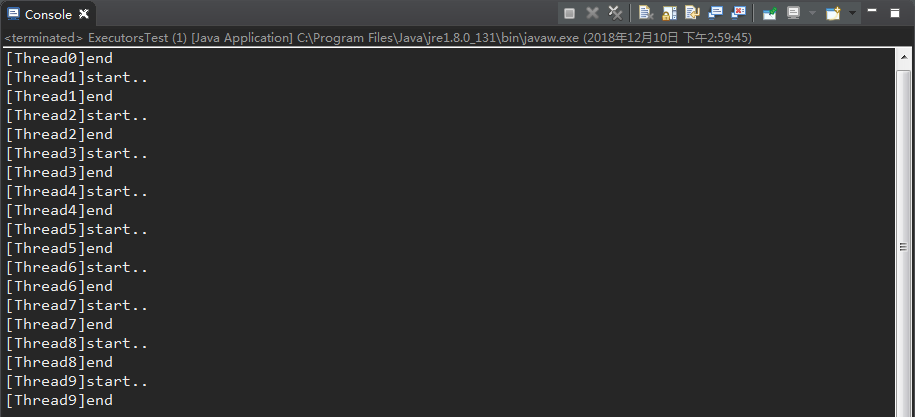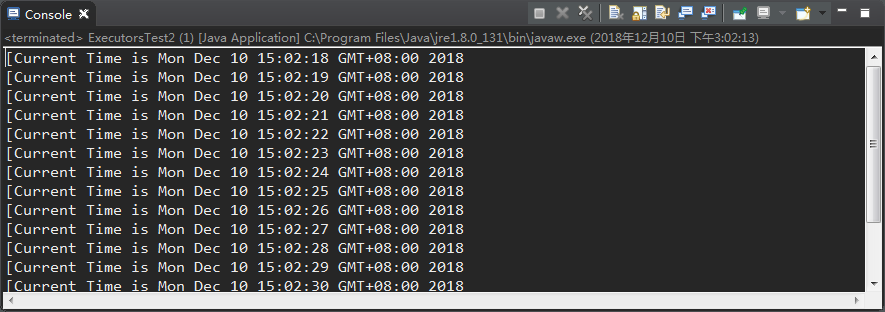1.使用线程池的好处

2.JUC中几种常用的线程池
java.util.concurrent包下的Executors工厂类,提供了一系列的线程池的创建方法,其构造方法如下:
public ThreadPoolExecutor(int corePoolSize, //线程池线程核心数量,线程池维护线程的最少数量 int maximumPoolSize, //线程池最大线程数量 long keepAliveTime, //空闲线程存活时间 TimeUnit unit, //存活时间的时间单位 BlockingQueueworkQueue, //存储任务的线程队列 ThreadFactory threadFactory, //线程工厂 RejectedExecutionHandler handler) { //拒绝策略 if (corePoolSize < 0 || maximumPoolSize <= 0 || maximumPoolSize < corePoolSize || keepAliveTime < 0) throw new IllegalArgumentException(); if (workQueue == null || threadFactory == null || handler == null) throw new NullPointerException(); this.corePoolSize = corePoolSize; this.maximumPoolSize = maximumPoolSize; this.workQueue = workQueue; this.keepAliveTime = unit.toNanos(keepAliveTime); this.threadFactory = threadFactory; this.handler = handler; }
其中常用的线程池有四种,分别是fixedThreadPool、cachedThreadPool、ScheduledThreadPool和SingleThreadExecutor。他们分别适用在不同的场合。
2.1 newFixedThreadPool
特点:
-
- 用于创建一个可重用、固定线程数量的线程池;
- 当线程池中线程都处于运行中时,新来的线程会进入等待状态,直到线程池中出现一个空闲线程;
- 当一个线程在任务中途退出、终止时,会有一个新的线程来替代它继续完成后面未完成的任务。
- 除非采用显式关闭的方法去关闭某个线程,否则线程会一直存在,不会释放资源。
- 任务存储在无界阻塞队列中
- 适用场景:长期任务
构造方法:
public static ExecutorService newFixedThreadPool(int nThreads) { return new ThreadPoolExecutor(nThreads, nThreads, 0L, TimeUnit.MILLISECONDS, new LinkedBlockingQueue ()); }
实例代码:
import java.util.concurrent.ExecutorService;import java.util.concurrent.Executors;import org.junit.Test;public class ExecutorsTest extends Thread{ private int index; public ExecutorsTest(int i) { this.index = i; } public void run() { try { System.out.println("[Thread"+this.index+"]" +"start.."); Thread.sleep((int)(Math.random()*10000)); System.out.println("[Thread"+this.index+"]" + "end"); }catch(Exception e) { e.printStackTrace(); } } public static void main(String args[]) { ExecutorService service = Executors.newFixedThreadPool(4); for(int i=0;i<10;i++) { service.execute(new ExecutorsTest(i)); } service.shutdown(); }}

因为线程池中线程数量一共有4个,所以当一次有大于4个的任务需要执行时,因为线程池中无空闲线程,后续任务进入等待状态,当其他任务执行完毕后,线程空闲,则马上开始执行正在等待的任务。
2.1 newCachedThreadPool
特点:
- 线程池数量上限为:Integer.MaxValue(2147483647);
- 线程池默认空闲60S,超过60S会从线程池中移除;
- 新来任务时,先检查是否有空闲线程可使用,若无,则创建一个新线程执行任务;
- 任务存储在同步队列中。
- 适用场景:短时异步任务。
构造函数:
public static ExecutorService newCachedThreadPool() { return new ThreadPoolExecutor(0, Integer.MAX_VALUE, 60L, TimeUnit.SECONDS, new SynchronousQueue ()); } 示例代码:
1 import java.util.concurrent.ExecutorService; 2 import java.util.concurrent.Executors; 3 4 import org.junit.Test; 5 6 public class ExecutorsTest extends Thread{ 7 private int index; 8 public ExecutorsTest(int i) 9 {10 this.index = i;11 }12 13 public void run() 14 {15 try 16 {17 System.out.println("[Thread"+this.index+"]" +"start..");18 Thread.sleep((int)(Math.random()*1000));19 System.out.println("[Thread"+this.index+"]" + "end");20 }catch(Exception e) 21 {22 e.printStackTrace();23 }24 }25 26 27 28 public static void main(String args[]) 29 {30 ExecutorService service = Executors.newCachedThreadPool();31 32 for(int i=0;i<10;i++) 33 {34 service.execute(new ExecutorsTest(i));35 }36 try {37 Thread.sleep(1000);38 } catch (InterruptedException e) {39 // TODO Auto-generated catch block40 e.printStackTrace();41 }42 43 for(int i=0;i<5;i++) 44 {45 service.execute(new ExecutorsTest(i));46 }47 48 service.shutdown(); 49 50 } 
创建10个工作线程用于处理任务,当线程执行完毕后,处于空闲状态,此时若出现新的任务,则会从线程池中用空闲的线程来处理新的任务。若没有空闲线程,则开启新线程处理。
2.3 newSingleThreadExecutor
特点:
- 创建一个单个Worker的线程;
- 线程会按照顺序依次执行;
- 任务存储在无界阻塞队列中
- 适用场景:需要按照顺序执行的任务。
构造方法:
public static ExecutorService newSingleThreadExecutor() { return new FinalizableDelegatedExecutorService (new ThreadPoolExecutor(1, 1, 0L, TimeUnit.MILLISECONDS, new LinkedBlockingQueue ())); } 实例代码:
import java.util.concurrent.ExecutorService;import java.util.concurrent.Executors;import org.junit.Test;public class ExecutorsTest extends Thread{ private int index; public ExecutorsTest(int i) { this.index = i; } public void run() { try { System.out.println("[Thread"+this.index+"]" +"start.."); Thread.sleep((int)(Math.random()*1000)); System.out.println("[Thread"+this.index+"]" + "end"); }catch(Exception e) { e.printStackTrace(); } } public static void main(String args[]) { ExecutorService service = Executors.newSingleThreadExecutor(); for(int i=0;i<10;i++) { service.execute(new ExecutorsTest(i)); } service.shutdown(); }} 
出现多个任务时,SingleThreadExecutor会按照顺序依次执行各个任务。
2.4 newScheduledThreadPool
特点:
- 任务存储在无界延迟队列中
- 适用场景:需要定期执行或延迟执行的任务
构造方法:
public static ScheduledExecutorService newScheduledThreadPool(int corePoolSize) { return new ScheduledThreadPoolExecutor(corePoolSize); } public ScheduledThreadPoolExecutor(int corePoolSize) { super(corePoolSize, Integer.MAX_VALUE, 0, NANOSECONDS, new DelayedWorkQueue()); } 实例代码一(scheduleAtFixedRate的使用):
import java.util.Date;import java.util.concurrent.Executors;import java.util.concurrent.ScheduledExecutorService;import java.util.concurrent.TimeUnit;public class ExecutorsTest2 extends Thread{ private int index; public ExecutorsTest2() { } public void run() { try { System.out.println("[Current Time is "+new Date().toString()); }catch(Exception e) { e.printStackTrace(); } } public static void main(String args[]) { /* * 执行定时任务newScheduledThreadPool */ ScheduledExecutorService service = Executors.newScheduledThreadPool(10); //5秒后开始执行,每隔一秒执行一次 service.scheduleAtFixedRate(new ExecutorsTest2(), 5, 1, TimeUnit.SECONDS); }} 
scheduleAtFixedRate方法,一共四个参数,分别是:需要执行的任务task、延迟执行时间t1、每次执行任务的时间间隔t2、时间间隔单位。 含义是:在t1时间过后,以 1次/t2 的频率来不断执行 task。 上述代码中,在5秒延迟后,以 1次/1秒的频率执行 打印当前时间的任务。
实例代码二(scheduleWithFixedDelay的使用):
1 import java.util.Date; 2 import java.util.concurrent.Executors; 3 import java.util.concurrent.ScheduledExecutorService; 4 import java.util.concurrent.TimeUnit; 5 6 public class ExecutorsTest3 extends Thread{ 7 private int index; 8 public ExecutorsTest3() 9 {10 }11 12 public void run() 13 {14 try 15 {16 //每次任务大约耗时1秒17 Thread.sleep(1000);18 System.out.println("[Current Time is "+new Date().toString());19 20 }catch(Exception e) 21 {22 e.printStackTrace();23 }24 }25 26 public static void main(String args[]) 27 {28 /*29 * 执行定时任务newScheduledThreadPool30 */31 ScheduledExecutorService service = Executors.newScheduledThreadPool(10);32 33 //5秒后开始执行,每次任务执行完后延迟3秒后,继续执行下一次34 service.scheduleWithFixedDelay(new ExecutorsTest3(), 5, 3, TimeUnit.SECONDS);35 }36 } 
scheduleWithFixedDelay也是四个参数,分别是:待执行的任务Task,延迟时间t1,每次任务执行完毕后延迟t2秒后执行下次任务,延迟时间单位。